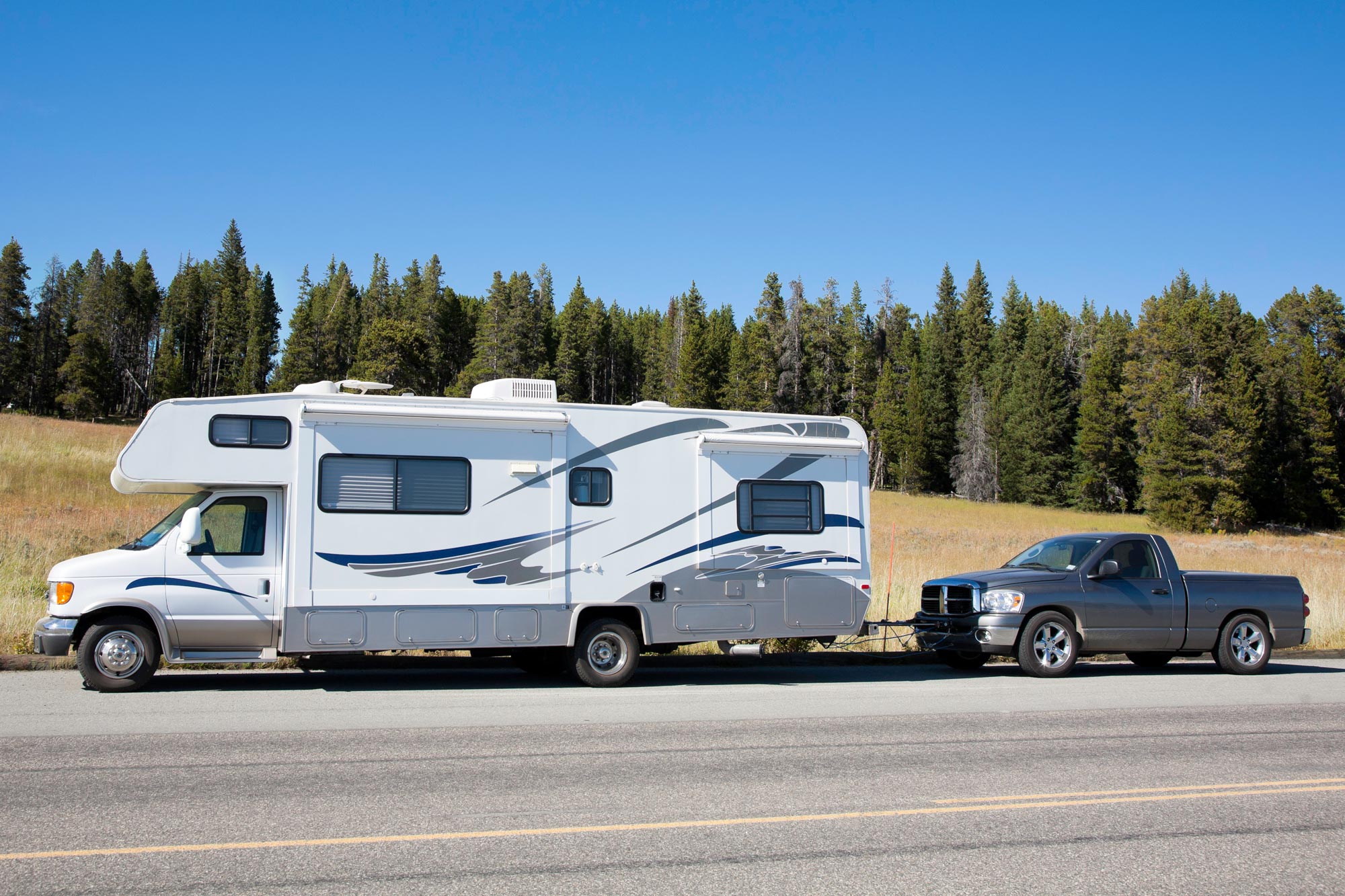What Is Flat Towing?
With the right equipment, you can safely tow a second vehicle with all four wheels on the ground instead of using a trailer.
 Getty Images
Getty Images
Unlike tow trucks or dollies that lift a vehicle's front or rear wheels off the ground for towing jobs, flat towing — also known as dinghy towing — is an alternative method that leaves all four wheels on the ground.
Done in a safe fashion with the proper equipment, flat towing is popular among recreational vehicle (RV) owners for hauling a second vehicle for personal use — often that vehicle is as large as a full-size pickup truck or SUV.
But as an emergency method for towing a friend's non-running vehicle with a chain, cable, or towing strap, flat towing can be a dangerous idea. Here's how flat towing works and when it should be avoided entirely.
Flat Towing Can be a Simple Way of Ferrying a Second Vehicle
Tow trucks typically use a hoist to lift a disabled vehicle's front or rear wheels, or the vehicle can be entirely lifted off the ground on a flatbed tow truck. People doing cross-country moves often rent two-wheeled dollies or flatbed trailers to do a similar job of hauling a vehicle behind a moving truck.
Flat towing, on the other hand, is more convenient, especially for RV owners, as no additional trailer or dolly is required, and no awkward loading or unloading is necessary. Instead, tow bars are attached to the front of the towed vehicle, which connect to a hitch on the rear of the RV or vehicle doing the pulling. Emergency safety chains are also part of the tow-bar setup.
The towed vehicle effectively becomes a four-wheeled trailer, coasting behind the towing vehicle. Turn and brake signals are also electronically connected, and drivers can remotely control their towed vehicle's braking to help compensate with the added weight.
Legal and Mechanical Requirements for Flat Towing
Provided that flat towing is legally allowed in your state — there are rules regarding towed-vehicle weight limits — the basic requirements are electrical connections for brake and running lights and turn signals, just like a traditional trailer. Auxiliary braking systems are also mandatory in most states.
Mechanically, flat towing is not suitable for many modern cars, trucks, or SUVs. It's ideal for vehicles with manual transmissions, which allow the car to be placed in neutral and roll easily as they're towed. Even four-by-four vehicles can be flat towed, provided the transfer case is disengaged and the wheels roll freely.
Vehicles with automatic or continuously variable transmissions can be easily damaged, as it's far more difficult, if not impossible, to place them in neutral. Vehicles must be intentionally designed to be towed in this manner for it to be safe. Flat towing can also be a challenge on vehicles where the steering column locks solid when the vehicle is turned off, as the front wheels need to be able to turn to follow the towing vehicle through corners.
Flat Towing Poses a Number of Risks
While you may intend to do a favor by flat towing a friend's broken-down vehicle behind you, it's absolutely unsafe to do without the right equipment. Towing a disabled vehicle — which likely lacks braking power and full steering control — means the other driver could easily run into you or other vehicles. The tow chain or strap can also break, causing even more safety issues. Not to mention legal ramifications. You're better off calling a tow truck, for short-distance tow as well as long-distance ones.
Even with tow bars and electrical connections, flat towing can lead to additional wear on the towed vehicle's components. All four tires get extra mileage, as do bearings and other parts that are in motion as the vehicle is towed. Far more damage can occur to the transmissions and drivetrain of vehicles without a manual transmission, as those parts will also be in motion as the car is flat towed.
Backing up with a flat-towed vehicle is also not advised, as the lack of steering control can bend the tow bars and damage both vehicles.
Written by humans.
Edited by humans.
 Andy Stonehouse
Andy StonehouseAndy Stonehouse literally fell into the world of auto writing while working as a ski-town journalist, and has not looked back since. A childhood spent dealing with the eccentricities of a 1976 MG Midget has made any subsequent auto experience a more safe and reliable drive. He has been blessed with nearby mountain trails and snowy roads in Colorado to do TV-adventure-styled test drives on a weekly basis.
Related articles
View more related articles